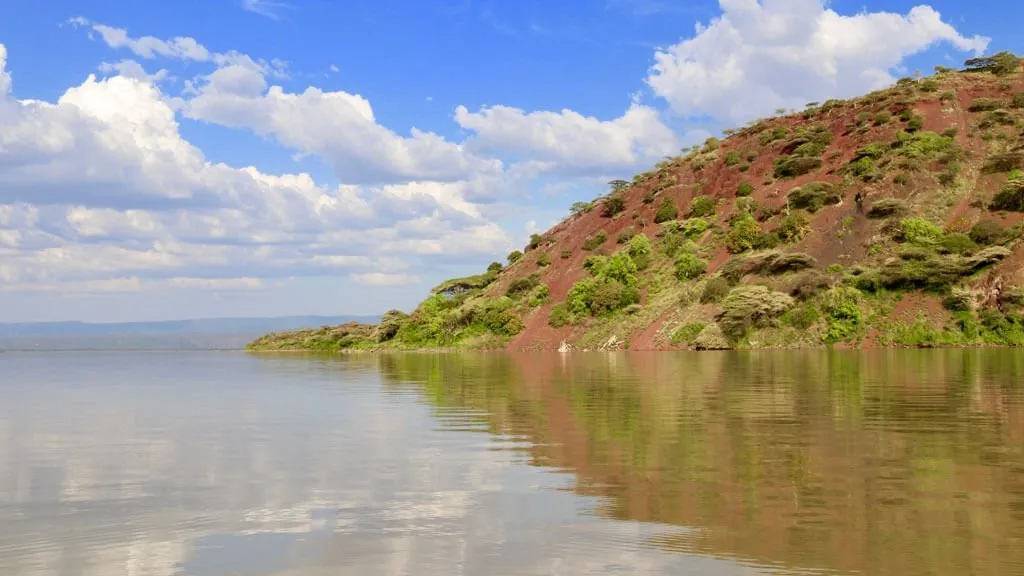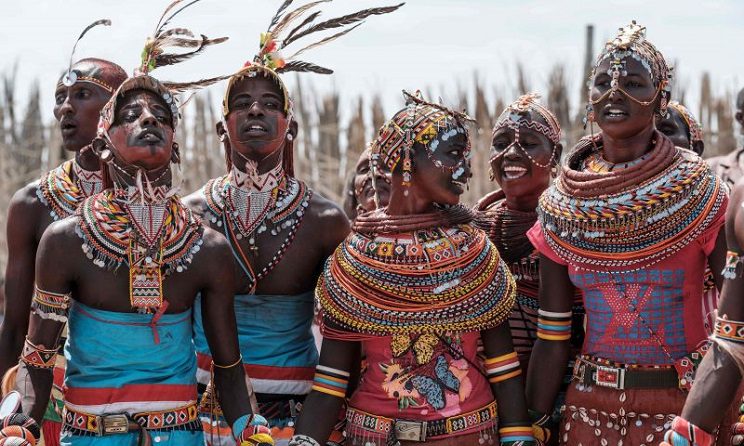DISCOVER UGANDA
Lake Baringo
Lake Baringo is not only a sight to behold but also a haven for a remarkable array of wildlife.
Amidst the stunning landscapes of the East African Rift system lies a natural wonder that captivates the hearts of visitors with its beauty and biodiversity – Lake Baringo in Kenya. This picturesque bird lake is a vital part of the scenic Tugen Hills, an uplifted fault block boasting volcanic and metamorphic rocks, while the Laikipia Escarpment graces its eastern shores. Lake Baringo is not only a sight to behold but also a haven for a remarkable array of wildlife. Its waters receive a precious flow from the Mau Hills and Tugen Hills, creating a critical habitat for more than 500 species of birds and fauna. Many migratory waterbird species find solace here, making Lake Baringo significant on regional and global scales. Moreover, the lake supports seven freshwater fish species, including the endemic Nile tilapia subspecies, Oreochromis niloticus baringoensis.
The lake’s importance extends beyond its natural wonders, as it plays a vital role in the social and economic development of the local communities. Fishing in the lake has been an integral part of the region, supporting livelihoods and providing sustenance. However, the stock of Nile tilapia has declined in recent years, giving way to the success of another species introduced in 1974 – the marbled lungfish. Droughts and excessive irrigation have impacted the water levels, leading to increased turbidity caused by sedimentation from intense soil erosion in the surrounding catchment area.
While Lake Baringo offers a rich ecological landscape, a recent study has highlighted the presence of recovered parasites in the endemic fish species, emphasizing the need for public awareness regarding the risks associated with consuming undercooked infected fish. Amidst the lake’s glistening waters lie several small islands, with Ol Kokwe Island taking center stage. This volcanic island, connected to Korosi volcano, boasts remarkable features such as hot springs, fumaroles, and sulfur deposits.
Lake Baringo’s significance goes beyond its natural splendor. The region is also home to important archaeological and paleontological sites, uncovering fascinating fossil records of hominoids and hominins within the sedimentary sequences of the nearby Tugen Hills. The main town near the lake, Marigat, serves as a gateway to this mesmerizing destination, while smaller settlements like Kampi ya Samaki and Loruk offer a glimpse into the pastoralist ethnic communities residing in the area.
Birding in Lake Baringo
Lake Baringo in Kenya is a birding paradise that attracts bird enthusiasts from around the world. With its diverse habitats, the lake provides a haven for over 500 species of birds, making it a must-visit destination for ornithologists and nature lovers. The lake’s varied ecosystems, including wetlands, acacia woodlands, cliffs, and open savannahs, create a rich and dynamic environment for avian life. Lake Baringo is home to numerous resident bird species, as well as migratory birds that seek refuge during their long journeys. The lake’s strategic location along major migratory routes adds to its significance as a birding hotspot.
Among the notable bird species found in Lake Baringo is the Goliath Heron, Africa’s largest heron. This magnificent bird with its impressive size and striking plumage can be spotted along the lake’s shores. Other heron species such as the Squacco Heron, Black Heron, and Grey Heron are also commonly seen. Lake Baringo is renowned for its fish-eating birds, including various kingfisher species. The Malachite Kingfisher, Pied Kingfisher, and Giant Kingfisher are frequent visitors, showcasing their vibrant colors as they dive into the lake in search of prey. The African Fish Eagle, with its majestic appearance and distinctive call, is a symbol of the lake and can be observed perched on trees or soaring above the waters.
Waterfowl species are abundant, with the Egyptian Goose, White-faced Whistling Duck, and African Jacana being among the notable sightings. The African Darter, commonly known as the Snakebird, is an interesting species that can be seen swimming with only its neck and head above the water, resembling a snake. The cliffs surrounding Lake Baringo provide nesting sites for several raptor species. Look up to the skies to spot the Verreaux’s Eagle, Lanner Falcon, and African Hobby, among others. The cliffs are also home to the cliff-dwelling Hemprich’s Hornbill, which creates nests in crevices.
To enhance the birding experience, guided boat trips can be arranged, allowing visitors to explore the lake’s diverse habitats and get closer to the bird life. Knowledgeable local guides can help identify and interpret the behaviors of the different bird species, making the birding experience even more rewarding. Birdwatching enthusiasts can also venture beyond the lake’s immediate vicinity to explore the surrounding acacia woodlands and the nearby Tugen Hills. These areas offer additional opportunities to spot species such as the African Grey Hornbill, Red-fronted Tinkerbird, and Golden-breasted Starling.
Lake Baringo is a year-round birding destination, but the best time to visit for birdwatching is during the dry season (December to March). At this time, the lake’s water levels are lower, concentrating birdlife along the shoreline and providing clearer visibility. With its remarkable bird diversity and stunning natural surroundings, Lake Baringo offers a captivating birding experience that will leave birdwatchers in awe. The combination of abundant species, scenic landscapes, and knowledgeable guides makes it an ideal destination for both novice and experienced birders seeking unforgettable encounters with the feathered wonders of East Africa.
What is the distance between Baringo and Nairobi?
Baringo is located approximately 216 km away from Nairobi, with a road distance of 253.3 km. If you are wondering about the travel time from Baringo to Nairobi, it typically takes around 3 hours and 20 minutes, including any necessary transfers.


Is LakeBaringo a salt water lake or fresh water lake?
Lake Baringo is a fresh water lake. It is not a saltwater lake like some of the lakes found in the Great Rift Valley, such as Lake Turkana. The water in Lake Baringo is not saline and is suitable for various freshwater species, including fish and birds.
What is the distance between Baringo and Nairobi?
Baringo is located approximately 216 km away from Nairobi, with a road distance of 253.3 km. If you are wondering about the travel time from Baringo to Nairobi, it typically takes around 3 hours and 20 minutes, including any necessary transfers.


Which ethnic groups reside in Baringo County?
Baringo County, home to a diverse population, is primarily inhabited by the Tugen, Pokot, and Ilchamus communities. These three ethnic groups form the majority in the county. Additionally, Baringo County is home to various minority communities, including the Endorois, Nubians, Ogiek, Kikuyu, and Turkana. The coexistence of these different ethnicities contributes to the rich cultural fabric and diversity of Baringo County. The Baringo County Government recognizes the significance of these communities and works towards promoting inclusivity and development for all residents, ensuring that their unique cultural heritage is respected and preserved.
What is the depth of Lake Baringo?
Lake Baringo, located in the west-central region of Kenya, is a prominent feature in the Great Rift Valley. Situated at an elevation of 3,200 feet (975 meters) above sea level, it lies to the east of the Kamasia (Ilkamasya) Hills. With a surface area of approximately 50 square miles (129 square kilometers), Lake Baringo stretches 11 miles (18 kilometers) in length and spans 5 miles (8 kilometers) in width. The lake’s average depth is recorded at 17 feet (5 meters).

Fish in Lake Baringo
Lake Baringo is home to a diverse array of fish species, enriching its vibrant aquatic ecosystem. The lake supports a variety of freshwater fish, including the endemic Oreochromis niloticus baringoensis, a subspecies of Nile tilapia. Other notable fish species found in Lake Baringo include catfish, lungfish, and barbs. The presence of these fish not only contributes to the biodiversity of the lake but also plays a crucial role in sustaining the local communities that depend on fishing for their livelihoods. Fishing activities in Lake Baringo provide an important source of income and food for the surrounding communities, fostering a connection between human and aquatic life.
Visitors to Lake Baringo can witness the traditional fishing practices and engage with the local fishing communities, gaining insights into their sustainable fishing techniques and the cultural significance of fish within the region. Whether it’s observing the fishing boats dotting the lake’s surface or savoring the delicious local fish dishes, the fish of Lake Baringo form an integral part of the lake’s ecosystem and the lives of the people who call it home.
The rising water situation happening to Lake Baringo and other Kenya Rift Valley Lakes
The Kenya Rift Valley Lakes, including Lake Baringo, are currently experiencing a significant rise in water levels, presenting both challenges and opportunities for the region. Factors such as increased rainfall, climate change, and human activities have contributed to this phenomenon. The rising water levels have resulted in the expansion of the lake’s surface area, causing flooding in lakeside communities and displacing local residents. This has had a profound impact on their lives and livelihoods. However, the situation also brings potential benefits, as the increased water volume rejuvenates the ecosystem and enhances the biodiversity of the lakes.
The abundant water resources offer new opportunities for activities like fishing, boating, and water-based tourism. Efforts are underway to manage the rising water situation effectively, including the relocation of affected communities, implementing sustainable land use practices, and engaging in conservation initiatives. It is crucial to strike a balance between addressing the challenges posed by the rising water levels and harnessing the potential benefits for the local communities and the environment. By adapting to these changing conditions, Lake Baringo and the other Rift Valley Lakes can continue to be valuable ecological and economic resources for Kenya.

Lake Baringo Reptile Park
This unique park offers visitors the opportunity to explore the fascinating world of reptiles up close. The park is home to a diverse collection of reptile species, including crocodiles, snakes, lizards, and tortoises. Visitors can embark on guided tours led by knowledgeable experts who provide valuable insights into the biology, behavior, and conservation efforts of these incredible creatures. The park aims to educate and raise awareness about the importance of reptiles in the ecosystem and their role in maintaining a balanced natural environment. It offers an engaging and interactive experience, allowing visitors to observe and learn about these reptiles’ natural habitats and habits. With its well-maintained facilities, informative exhibits, and interactive shows, Lake Baringo Reptile Park offers an unforgettable adventure for nature enthusiasts, families, and wildlife lovers.
Touring Kerubo Swamp on Lake Baringo
Touring Kerubo Swamp on Lake Baringo offers a captivating and immersive experience in the heart of Kenya’s natural beauty. As one of the largest swamps in the region, Kerubo Swamp is a haven for diverse bird species and other wildlife. Visitors can embark on guided tours, navigating through the lush vegetation and tranquil waters to witness the rich biodiversity that thrives within the swamp. The knowledgeable guides provide insights into the various bird species, including herons, kingfishers, and African fish eagles, that call this wetland home. The serenity of the swamp, coupled with the symphony of bird calls, creates a mesmerizing atmosphere for nature enthusiasts and birdwatchers. Exploring Kerubo Swamp on Lake Baringo offers an opportunity to connect with the pristine wilderness and appreciate the delicate balance of the ecosystem while enjoying the stunning views and discovering the hidden treasures of this remarkable wetland habitat.


Accommodations near Lake Baringo
As tourism interest continues to grow, visitors to Lake Baringo can find a range of accommodation options, including hotels, self-catering cottages, and camping sites. Boating services are available along the western shore, particularly near Kampi-Ya-Samaki, as well as on the charming islands dotting the lake’s expanse. However, it is essential to note that the lake’s surface area has experienced a significant increase over the past decade, leading to the displacement of lakeside villages.
Lake Baringo offers a range of accommodation options for visitors to enjoy their stay near this beautiful lake. Island Camp Baringo is a highly-rated choice, providing a child-friendly environment and amenities. Tumbili Cliff Lodge Limited Lake Baringo is another excellent option, offering a 3-star hotel experience and also catering to families with children. Soi Safari Lodge, a 4-star hotel, is known for its child-friendly atmosphere and comfortable accommodations. For a unique experience, Samatian Island provides a tranquil setting with stunning lake views. Roberts’ Camp is another popular choice, known for its child-friendly facilities.
Sandai Resort offers a more affordable option with child-friendly amenities. Additional options include Samatian Island Lodge Jetty and Royal Doves Garden. These accommodations provide various amenities, including picturesque surroundings, comfortable rooms, and options suitable for families. Visitors to Lake Baringo can choose from these diverse accommodation choices to enhance their experience and enjoy the natural beauty of the lake.






